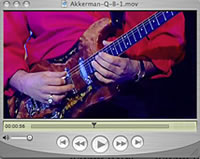Langcaster Ultimate-Lo three-pickup Strat kitset assembly has the following unique specifications:
|
|
| THE ULTIMATE LO-IMPEDNCE PICKUP - Review by Cees Bakker for GuitarPlus magazine.
Langcaster has come up with the answer; a humbucking pickup called the Ultimate Lo. The Ultimate Lo uses a much heavier gauge of wire with only a tenth of the number of turns. This makes the inductance 100th that of a conventional pickup. Self-resonance is as high as 56KHz - beyond the range of human hearing. The resistance is a mere 100 ohms because of the few turns and thicker wire. The pickups are, as a bonus, much more resistant to corrosion and damage. All Langcaster pickups are wax sealed and use a copper-coated pickup cover. There is no loss caused by this cover as happens with high impedance pickups. Copper laminate on glass epoxy laminate is used at the coil ends. How can we use a pickup with so few turns? Well, of course we now have seen active pickup preamplifiers powered by a 9 Volt battery for some years now. Langcaster developed their own low noise preamplifier matching the pickups to the guitar amplifier and eliminating the effect of even the longest guitar cable. By designing a tone control that works independently of pickup parameters, a consistent and smooth working range can be obtained. Loading and resonance can be selected and controlled to achieve a response that is just stunning. Guitarists immediately react with favour on hearing the first chord played on a Langcaster guitar fitted with the Ultimate Lo The preamp is designed with discrete transistors so that an extremely low current is drawn from the battery. Long battery life is then assured so that the battery lasts almost as long as its shelf life. No compromise has been made in the output capability either. The buffer stage has a capability of driving the volume pot to 2.5 Volts RMS which is hardly likely to be required in normal playing. Two output jacks are provided. ULTRA DRIVE Overdrive System Following this buffer stage is an overdrive circuit that has been years in development. A toggle switch selects the overdrive or clean function. The overdrive stage consists of a balanced long-tailed pair and a PNP output transistor using feedback. The clipping produced by this circuit does not require any device to go into saturation which means that battery voltage does not influence the resulting signal. There is no level shifting at the input so the signal is centred at zero at all times resulting in a consistent and smooth overdrive. Many other stomp box types of overdrive using transistors or FET's do not have this feature. Low order harmonics are produced which are musical and sound like a valve amplifier – no harsh raspiness at all. No more stomp boxes to trip over; it's all at the fingertips. No rush to the amplifier to adjust the overdrive volume either. It can all be controlled from the guitar. What can be handier than that? What can be said about the qualities of this overdrive? Truly, it has to be heard to be believed.
ANTHOLOGY High impedance pickups have been around since 1931 when Rickenbacker introduced the horse shoe pickup for their lap steel guitar. In 1934 Gibson commissioned the design of a new guitar pickup to Loyd Loar. Later developments by designers such as Leo Fender, Seth Lover, Larry Dimarzio, Seymour Duncan, Greg Kinman and many others produced various designs of hum-bucking single coil and double coil pickups with ceramic, ferrite or Alnico magnets. Nothing radical has changed in the basic pickup except for these various designs to cancel electromagnetic fields which caused hum. In those days, valves ruled supreme so a strong signal was required to drive the amplifiers of the day. The Gibson's classic double coil hum-bucker pickup had resistance of 6 to 7.5 Kohm and were wound with 42 Gauge Enamelled copper wire. The magnets are reversed in one pickup so the signal from the strings are in phase but stray hum is out of phase and therefore cancelled. Other designs place one coil above and one coil below on the same former. The two windings are wired out of phase so that enveloping stray hum fields are cancelled but there is only a small amount of cancellation of the signal produced by the string vibration. The first one who developed such pickup was Jim Burns, who introduced in 1965 his Bar-O-Matic pickups followed in the nineties by Seymour Duncan. Pickups can be selected for their characteristic tone which is dependent on the magnets used and the number of turns in the coil among other things. More turns not only increases the resistance linearly, but also the inductance on a square law ratio. As with all pickups, more turns of wire gives more power, thicker mids but weaker highs. Unfortunately there is a cost to having more turns. The cost is that the reactance part of the impedance rapidly rises to a level where the high frequencies are reduced in comparison to the mids. The quality of the tone is lost and the sound becomes dead. And with all that, the signal has to travel through well over 1 Kilometre of wire! Pickups vary in resistance and inductance but range between 2.5 and 10 Henrys. Inductance has a reactance (impedance) which rises with frequency. So at 4,000 Hz, a 10 Henry pickup with a resistance of 8 KOhms has a total reactance of (Z =2πfL) 251.3 KOhms for an impedance of 251.4 KOhms. This is calculated using the Pythagoras Law of vectors. For this reason we use 250K or 500K pots. Ever wondered why? At 4KHz, half our signal (-6dB) is lost! Any self-resonance is highly damped as well. RESONANCE and HOW IT AFFECTS the SOUND The resonant frequency of a pickup depends on both the inductance L and the capacitance C. C is the sum of the winding capacitance of the coil (usually about 80 - 200 pF) and the cable capacitance (about 300 - 1,000 pF). Since different guitar cables have different amounts of capacitance, it is clear that using different guitar cables with an unbuffered pickup will change the resonant frequency and hence the overall sound. Inductors, being wound layer upon layer have a winding capacitance which resonates with the inductance at a frequency determined by the formula: f = 1 ÷ 2π√LC. Pickups range in self-resonance between 2 KHz to 5 KHz with a loaded Q of perhaps 0.8 to 1.2. Q is a quality factor which engineers use to express bandwidth and is calculated with the formula: Q = f0 ÷ BW where BW is the bandwidth of resonance. It is the difference in frequency between the –3dB points of the resonant curve. The f0 represents the resonant frequency. The Q factor is decreased by the resistance loading the coil by the volume and tone pots and by the series resistance of the coil itself. The resonant frequency of most available (high impedance) pickups in combination with normal guitar cables lies between 2,000 and 5,000 Hz. This is the range where the human ear has its highest sensitivity. For example, a pickup with an inductance of 8 Henrys used with a guitar cable of 800pF and a winding capacitance of 150pf will have a resonance of only 1.8 KHz (1,800 Hz). This is sure to sound Ok for some guitarists, but most would feel robbed of tonal quality. Turning up the treble control on the amplifier can do little except increase the hiss. The correlation of frequency to sound is that at 2,000 Hz the sound is warm and mellow, at 3,000 Hz brilliant or present, at 4,000 Hz piercing, and at 5,000 Hz or more, brilliant. This is all relative to the middle response. The sound also depends on the height of the peak, of course. A high peak produces a powerful, characteristic sound; a low peak produces a weaker sound, especially with solid body guitars that have no acoustic body resonance. The height of the peak of most available pickups ranges between 0dB to +12 dB. It is dependent on the magnetic material in the coil, on the external resistive load, on any parallel capacitance added and on the metal case. Without the casing the peak is higher and is preferred by many guitarists. Conventional pickup coils are a compromise between output level and tone. There is a need for a pickup that eliminates these compromises and builds on quality and tone. Try the new Ultimate Lo and join those who have experienced the new technology. FEATURES of the ULTIMATE LO PICKUP SYSTEM
World class luthiers have now discovered the Langcaster Pickup system and using now Langcaster exclusive in there guitars. |


